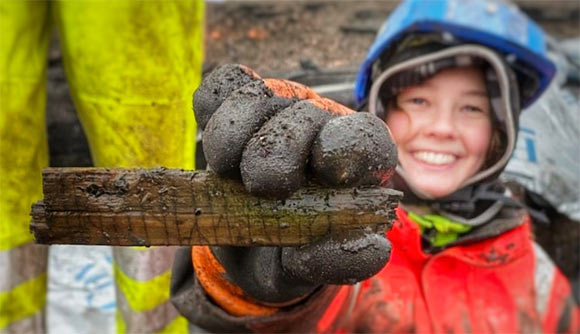Archaeologists excavating the Medieval Park in Oslo, Norway, have unearthed two objects — pieces of bone and wood — inscribed with runes.

The wooden artifact with text in both Norse and Latin found at the Medieval Park in Oslo, Norway. Image credit: Tone Bergland, Norwegian Institute for Cultural Heritage Research.
“The first find is a piece of bone with 13 runes on one side and a single rune on the other,” said Professor Kristel Zilmer, a researcher at the University of Oslo.
“The main inscription reads basmarþærbæin which can either relate to the name of a person who owned (i.e. used) the bone or can describe the type of bone.”
According to the team, the last four runes bæin — Old Norse bein which means ‘bone’ — refer to the bone itself.
“But our understanding of the whole text depends on how we interpret the first part of the inscription,” Professor Zilmer said.
“Basmarþær may contain the genitive form Marðar, which can be explained as the Scandinavian personal name Mår / Mård. To this, one has added the name element bas.”
“Bas as the first element in names is unusual. However, something similar can be found in a gravestone inscription from Skålvoll, as a spelling for Báts, genitive of the nickname Bátr, i.e. boat. If this is the case, then the text can mean ‘Boat-Mård’s bone’.”
“The reason for writing on the bone was not necessarily to show ownership of it, but maybe Mård sat there with free time after eating a meal, and used the opportunity to turn the leftover dinner into a writing tablet?”
“The other possible interpretation is the slightly funny word composition bás-marðarbein, meaning ‘boose(barn)goat’s bone’.”
“Mǫrðr occurs in Old Norse as a peculiar poetic label for ram,” Professor Zilmer said.
“Although the bone does not appear to be a sheep bone, it cannot be ruled out. If the bone comes from a horse or a cow, is the misleading inscription meant to entertain?”
The second artifact the archaeologists found is a flat piece of wood with inscription on three of its sides.
They think that the text combines religious texts in both Latin and Old Norse.
“On one side, we notice two words in Latin: manus and Domine or Domini. Manus means ‘hand’ and Dominus ‘Lord, God’,” they said.
“This is part of a well-known Latin prayer formula: In manus tuas, Domine, commendo spiritum meum (Into your hands, O Lord, I commend my spirit), known as Jesus’ last words on the cross.”
“The Old Norse text on the second side includes the name Bryngærðr.”
“On the third (narrow) side 8 small runes can make sense either as a statement in Latin or a continuation of the text in Old Norse. In the latter case, this may be the phrase ‘it is true’.”
“A possible interpretation is that the inscription contains a short prayer telling the reader about Bryngærðr who commended herself into the hands of God.”
Both artifacts were from refuse layers, possibly related to land reclamation in Oslo’s areas subject to flooding.
“The bone may relate to the earliest period of settlement as it was found close to the natural deposits,” said Dr. Mark Oldham, leader of the excavations.
“We cannot yet say exactly how old these two rune finds are, but scientific tests will hopefully provide the answers.”
“Similar runic finds in Norway date to the period 1100-1350 CE, while some are older. It may be possible however, to date the texts by examining the spelling and use of certain characters.”
“The use of so-called dotted runes on the wooden stick, as well as the distinction between a-rune and æ-rune on the bone are characteristic features of medieval runes,” Professor Zilmer said.
Source: sci-news.com
 Archeology News Archeology News
Archeology News Archeology News






